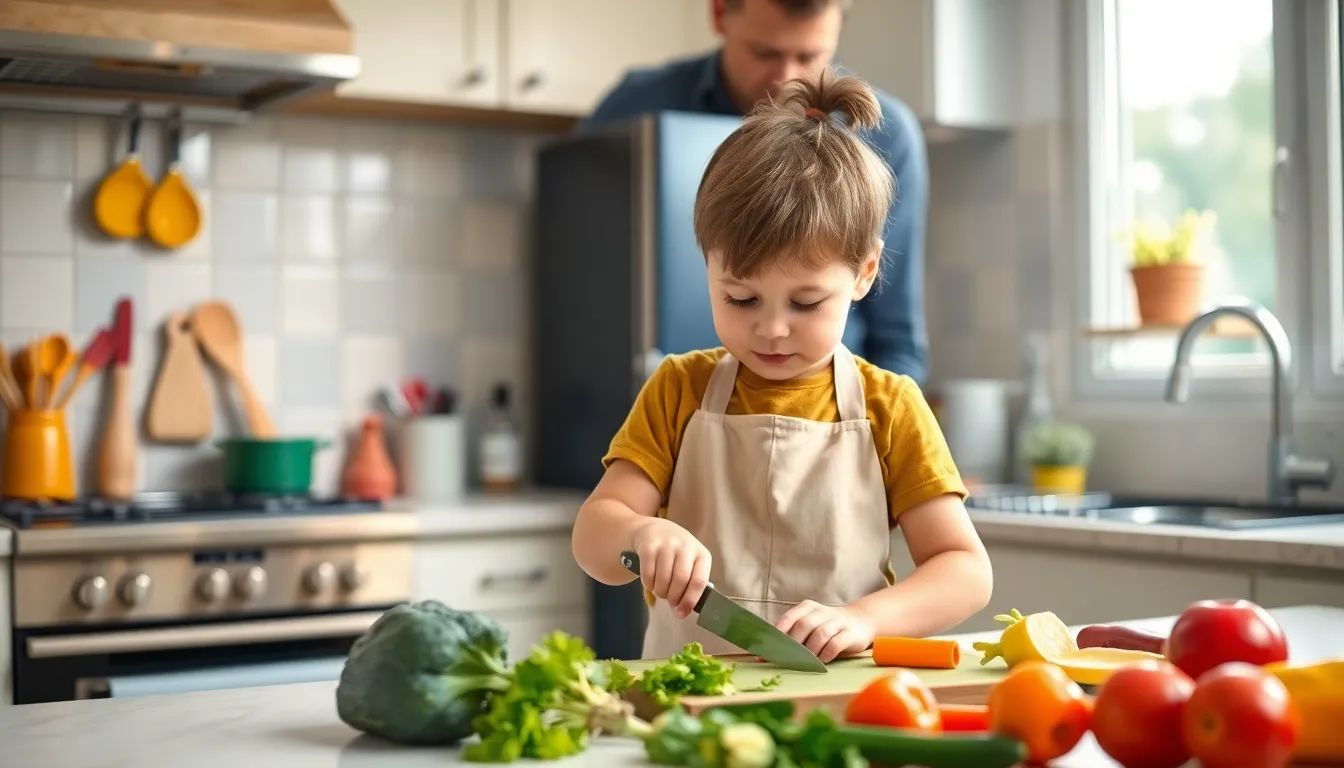Table of Contents
ToggleGetting kids into the kitchen can feel like a recipe for disaster, but it doesn’t have to be! With the right cooking tips, parents can turn their little ones into mini chefs who whip up delicious meals instead of just chaos. Imagine the joy of watching them master the art of pancake flipping or the sheer delight of homemade pizza night.
Cooking Tips for Kids
Involve children in meal preparation to enhance their cooking skills. Start with simple recipes that require minimal ingredients, making the process less overwhelming. Select age-appropriate tasks for each child; younger ones can mix ingredients, while older children can handle chopping fruits and vegetables with supervision.
Encourage creativity by allowing kids to customize dishes, such as adding their favorite toppings to homemade pizzas. Teach kitchen safety rules, like how to properly use utensils and handle hot surfaces. Explain the importance of washing hands before cooking to maintain hygiene.
Use colorful ingredients to make meals visually appealing, stimulating interest and excitement during cooking sessions. Incorporate measurements to teach basic math skills, ensuring that children learn while having fun.
Plan cooking sessions around themes, such as “Taco Tuesday” or “Pasta Night,” to keep them engaged. Share cooking responsibilities, allowing each child to take turns leading a dish. Setting a timer can add a fun challenge as they learn to manage cooking times.
Create a recipe book together, documenting the meals prepared, fostering a sense of accomplishment. Introduce them to kitchen tools, like a whisk or measuring cups, explaining their uses. Cooking as a family builds memories and strengthens bonds while teaching practical skills.
Experimenting with tastes and textures can spark curiosity about nutrition, promoting healthier choices. Emphasizing teamwork in the kitchen ensures that kids work collaboratively, making the experience more enjoyable.
Essential Kitchen Safety

Involving kids in cooking requires a focus on safety. Parents must implement essential kitchen rules to ensure a secure cooking environment.
Understanding Hot Surfaces
Hot surfaces pose significant risks in the kitchen. Children should always be informed that stovetops and ovens can cause burns. Teaching them to use oven mitts when handling pans helps prevent accidents. Always remind kids to keep a safe distance from hot items and ensure they know when it’s safe to approach. Placing cookware on stable surfaces minimizes the risk of tipping and spilling. Emphasizing that they should ask an adult before touching anything hot fosters safety awareness.
Proper Tool Handling
Proper handling of kitchen tools is crucial for avoiding injuries. Kids should be taught to use knives with caution, ensuring they cut away from their bodies. Using age-appropriate tools can build their confidence and skills. Explaining the purpose of each utensil precludes misuse. When using appliances, kids must understand the importance of following instructions. Always stressing the importance of returning tools to their proper places forms good habits. Encouraging them to ask for help enhances safety and ensures responsible use.
Fun and Easy Recipes
Exploring cooking together can lead to delicious creations. Kids enjoy trying out simple recipes that spark their imagination.
Simple Snacks Everyone Can Make
Fruit skewers make a colorful and healthy snack. Kids can choose their favorite fruits, like strawberries, grapes, or banana slices, and thread them onto sticks. Cheese and crackers create another easy option, where kids can pair different cheese types with various crackers. DIY popcorn is fun, too, as kids can add flavors like cheese or caramel to plain popcorn for a tasty treat. Smoothies offer a creative mix of fruits and yogurt, allowing kids to blend their concoctions.
Quick Meals for Young Chefs
Pasta serves as an excellent base for quick meals. Kids can boil pasta and mix it with store-bought sauce or a simple olive oil drizzle. Tacos bring excitement to the kitchen, as children can fill tortillas with ingredients like seasoned beef, beans, and colorful toppings. Sandwiches provide endless possibilities, whether it’s peanut butter and jelly or turkey and cheese. Pan-fried quesadillas allow kids to fill tortillas with cheese and veggies before cooking them on the stove. These meals help kids develop confidence in their cooking skills.
Teaching Kids Basic Skills
Teaching kids basic cooking skills fosters their independence in the kitchen. Young chefs benefit from hands-on experience and develop confidence over time.
Knife Skills for Beginners
Start with plastic or child-safe knives to ensure safety while learning. Gradually, kids can practice cutting soft fruits and vegetables, like bananas and cucumbers. Encourage them to use a cutting board to maintain a stable working surface. Demonstrating proper grip techniques keeps hands safe, while emphasizing the importance of keeping fingers tucked under fosters good habits. Utilize simple tasks, such as slicing bread or chopping herbs, to enhance their comfort level. As they gain experience, kids can progress to slightly more complex cutting tasks, under supervision.
Measuring Ingredients Accurately
Teach kids to use measuring cups and spoons through hands-on practice. Demonstrating how to fill cups to the brim accurately pinpoints the importance of precision in cooking. They can measure dry ingredients like flour and sugar first, making it easier to learn. Encouraging them to scoop and level off ingredients reinforces good habits. Liquid measuring cups serve a similar function for liquids. Show them how to bend down and check measurements at eye level for accuracy. Incorporating this skill helps children understand basic math concepts and leads to successful cooking results.
Encouraging Creativity in Cooking
Encouraging creativity in cooking helps children express themselves and fosters a love for food. By allowing kids to experiment, parents can create an engaging kitchen environment.
Flavor Combinations to Experiment With
Children can explore different flavor combinations while cooking. For instance, pairing sweet and savory ingredients like apples and cheese introduces them to new palates. Additionally, they might enjoy blending spices such as cinnamon in oatmeal or chili powder in tacos. Encourage kids to make their own sauces by mixing yogurt with herbs or creating marinades. Allowing them to taste-test and adjust flavors develops their confidence and intuition in the kitchen. Moreover, getting feedback on their creations builds a sense of accomplishment.
Decorating Dishes and Presentation
Decorating dishes adds an artistic touch to meals. Kids can use colorful fruits and vegetables to create fun designs on their plates. For example, arranging berries in a smiley face or using carrot slices to form flower shapes can engage their creativity. Teaching children about plating techniques helps them think critically about presentation. Sprinkling herbs or drizzling sauces can enhance both flavor and appearance. Creating a themed dinner night, such as a rainbow salad, encourages them to showcase their culinary skills in appealing ways. Ultimately, emphasizing presentation can make cooking a more enjoyable experience.
Getting kids involved in cooking can transform mealtime into a fun and educational experience. By following simple tips and prioritizing safety and creativity, parents can nurture their children’s culinary skills while fostering independence.
Encouraging kids to experiment with flavors and presentation not only makes cooking enjoyable but also empowers them to make healthier choices. As they learn essential skills and build confidence, families can create lasting memories together in the kitchen. Embracing this journey can lead to a lifelong love for cooking and a deeper appreciation for food.



